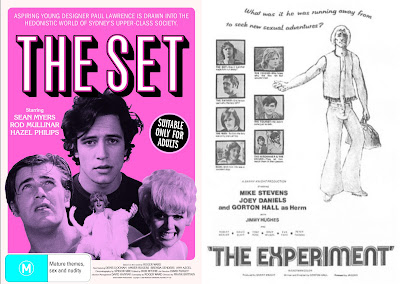But often self-discovery doesn’t start as a journey; it’s more like a prison escape. Escape is foremost in the mind of Paul (Sean Myers, billed as Sean McEuan) when he leaves the dreary seaside town where he lives with his miserable parents for the swinging life of 1969 Sydney in the 1970 Australian movie THE SET.
The catalyst for Paul’s departure is not, surprisingly, his crater-faced father insisting Paul take a job at the shipyards rather than waste his time at some candy-ass college. No, it’s after some beach ballin’ with his girlfriend Cara (Amber Rodgers, billed as Julie Rodgers), when she reveals that while in boarding school, she had an affair with—OMG!—a girl. This admission so horrifies Paul that he runs away, bare-assed naked, lest he get any more of Cara’s Sapphic cooties on him.
 |
| Paul doesn’t stay mad at Cara for long. Also, this scene is allegedly taking place at night (during May in Fairbanks, Alaska, apparently.) |
 |
| The Set didn’t win any awards, but Brenda Senders’ hair deserved Best in Show. |
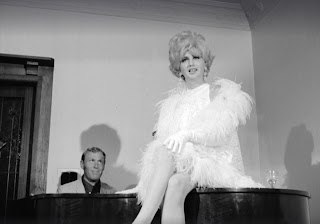 |
| RuPaul’s Drag Race: Bike Lane Edition. |
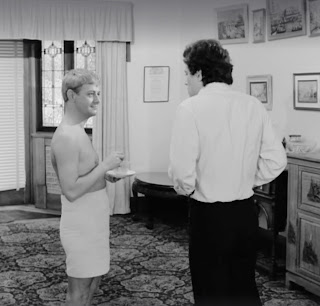 |
| Paul’s walk of shame is made more shameful. |
In the next scene Paul awakens alone in a strange bed. Though it’s implied he was roofied, the expression on his face when he looks in a mirror confirms he was well aware of what went on in that bed. Ashamed, he tries to sneak away, only to be confronted by Theo, wearing nothing but a towel. “Aren’t you even staying for breakfast?” he grins as Paul makes a run for it.
The movie takes its title from Paul’s primary job assignment from Mark Bronski: to design a set for a musical production. Though Paul is praised for having creative vision, he lacks the technical skill necessary to complete the job. Then he’s visited by his sexually frustrated aunt Peggy (TV presenter and comedienne Hazel Phillips in her film debut), his teen-aged cousin Kim (Bronwyn Barber) and Kim’s hot-for-1969 boyfriend Tony (Rod Mullinar, who went on to star in Breaker Morant and Dead Calm), who is studying engineering. Paul’s solution to his dilemma is to recruit Tony for collaboration on the set design. There’s just one hiccup: Tony is an asshole. He first scoffs at the suggestion, then reconsiders when Paul’s girlfriend Leigh, (Ann Aczel, the weakest actor of the bunch), whose hair could house a family of six in Whoville, drops in for a visit. Tony says he’ll help Paul on the condition he gets to move in with him, and Leigh moves in, too. Paul readily agrees, and so does Leigh, happily prostituting herself for the sake of her boyfriend’s career.
Alas, while Paul looks good, he’s a lousy lay. Like, really, really bad. “I am just feeling so damned let down and so frustrated that I could just kill you!” rages Leigh before storming out of the bedroom and the movie, never to be heard from again. Later, Aunt Peggy drops by and, finding Tony alone and not averse to sex with older women, decides to have what her daughter’s having, only to discover Kim’s likely never been served. “Oh, I just can’t win. A husband who’s lost all interest and a boy who wouldn’t know how,” she muses after Tony “leaves [her] in mid-air.” But unbeknownst to Peggy, Kim is being delivered by a plot contrivance taxi, and it drops her at the apartment just in time to discover her mother’s and her boyfriend’s betrayal.
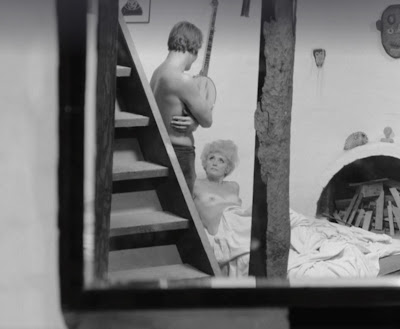 |
| Reflections of a failed fuck. |
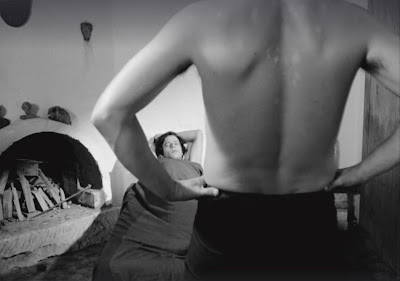 |
| Tony decides he and Paul should be roommates with benefits. |
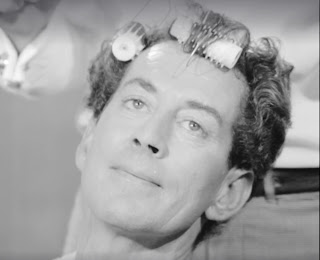 |
| John L. gets dolled up to meet his latest |
Paul survives, recovering in time to design something—with Tony’s help—for the famed producer. Then Paul finally meets “John L.” (Michael Charnley, flaming so hard it’s a wonder he doesn’t spontaneously combust), who makes it clear he plans to give Paul a #MeToo story to share 50 years down the road. But the producer’s plans are thwarted when Paul recognizes John L.’s “cold hard fish” secretary, and suddenly realizes he’s not queer, after all.
More an Aussie Curiosity than a Camp Classic
The Set is based on a then-unpublished novel by character actor Roger Ward (Janus Publishing ultimately published the book in 2011.) In an interview with FilmInk, Ward said every publisher he showed the manuscript to rejected it “not because I was an actor attempting to be a writer, but because I was a writer peddling filth.” Then a fellow actor got the manuscript in the hands of director Frank Brittain, who wanted to adapt the book into a movie. But there was a catch: “Frank told me I had to lift every homosexual narrative from the novel and write a screenplay on that.” Certainly not the note I would’ve expected, especially in the 1960s.
Ward’s assessment of the final product is it’s “a shit film,” which I think is a little too harsh. The Set isn’t good, but it’s not shit, either. A B-grade melodrama that mixes 1960s kitsch with grindhouse sleaze (its subject matter and nudity earned it an “adults only” label in its day, but it’s now rated PG-13), The Set seemed the type of movie I’d fall in love with at first viewing. But as much as I enjoyed the movie for its campy excess, its story is uninvolving. The script, co-written by director Brittain’s wife Diane, is more concerned with plot points than character development, so people’s actions come off as contrivances rather than rooted in character motivations. And for all that happens, the movie has almost as many moments of characters just standing there, silently, waiting for another character to finish packing his bags or another to begin her tirade. Did the editor not realize these parts were supposed to be cut out? Also, set design, at least as presented in The Set, isn’t the most gripping narrative driver. The model of Tony and Paul’s design, when we finally see it, looks like a creation from one of those At Your Fingertips educational shorts from the 1970s that are a staple of the RiffTrax catalog.
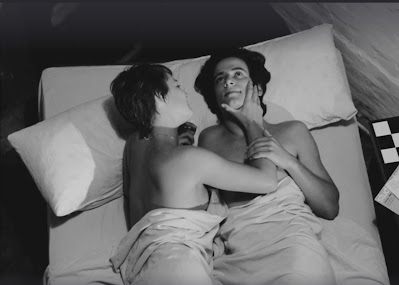 |
| Cara and Paul end up right where straight audiences demand. |
A Sensitive Coming Out Story or Hardcore Twink Action?
“I’ll never forget that summer—that restless summer, when I found out who I was, and that long walk to tell my father what I learned.” So recalls Billy Joe at the beginning of THE EXPERIMENT, setting the tone for this 1973 coming out drama. And for the first 20 minutes, watching Billy Joe (Mike Stevens, in his only film role) and his best friend Gary Lee (Joey Daniels) roughhouse in the desert, cool off in the swimming pool of what they think is a vacant house, and drink beer stolen from the fridge of the diner owned by Billy Joe’s dad, you might think this is a regular queer indie movie.
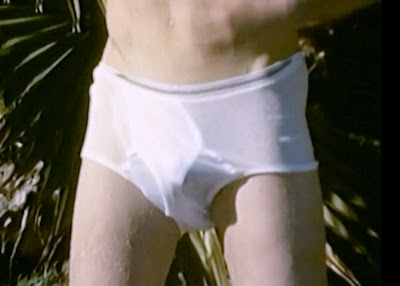 |
| Though there are hints of what’s to come. |
Then the dick sucking starts. Yup, it’s a porno! Billy Joe and Gary Lee giving same sex scrompin’ a try is the titular experiment (“Oh, Gary, it feels weird.”) The teens—at least we’re not meant to believe they’re older than 18—are awkward at first, but quickly get into it, taking turns blowing each other and even getting into a sixty-nine. The sex acts aren’t all that varied, which makes perfect sense. I always find it funny when present-day porn scenes attempt a similar scenario, where one, or both—or all three—guys are supposed to be inexperienced/straight, then end up deep throating like pros and getting DP’d with ease. I’m not saying it isn’t hot, it’s just not believable.
 |
| Billy Joe works up his nerve while Gary Lee lies back and waits. |
Anyway, back to Bill Joe and Gary Lee, who get off with some frottage. Alas, shame comes shortly after they do. The next morning Billy Joe wants to keep “experimenting,” but Gary Lee pushes him away. Just like Paul in The Set, Billy Joe flees—not just the shed in which he and Gary Lee sucked each other off, but the small southwest town where he lives, hitting the road for Los Angeles.
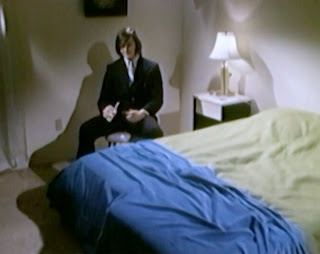 |
| Jimmy Hughes prepares for his scene. |
Billy Joe might be nervous, yet he’s intrigued, too, and so will you once Hughes gets naked. His ‘70s hair may not be for every taste, but his muscular physique has timeless appeal (too bad he’s a convicted rapist). Yet, the salesman’s hot bod isn’t enough to silence Billy Joe’s self-loathing inner dialog: “Goddamn you, Gary. Goddamn you for making me see what I really am.” Then, as so often happens, Billy Joe gets too horny to give a shit about his conflicted feelings, going from lying there like a cadaver to writhing like a voracious cock gobbler.
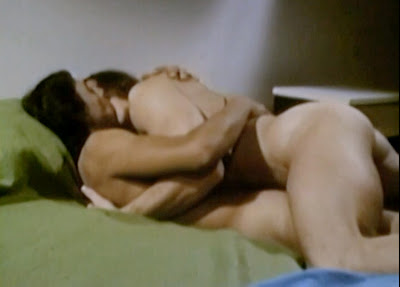 |
| Self-loathing cured. |
 |
| It might have something to do with David Craig’s Grinch-like smile. (I hadn’t anticipated that this post’s movies would each merit a Dr. Seuss reference, but there you go.) |
 |
| Better call (Gorton) Hall. |
Billy Joe has found a Hollywood dude of his own, and it’s from his home that Billy Joe calls his father. He assures his dad he’s OK; there are just some things he needs to figure out on his own (a touching scene, actually). Billy Joe’s Hollywood dude is the skinny son of a film director who looks like a cross between Jason Gould (a.k.a. Barbra’s son) and Jane Adams. Billy Joe is visibly creeped out by him, but the director’s son persuades him to stay. “I thought there were some things you had to find out about yourself. I can think of no better place than in my basement. Call it the acid test.”
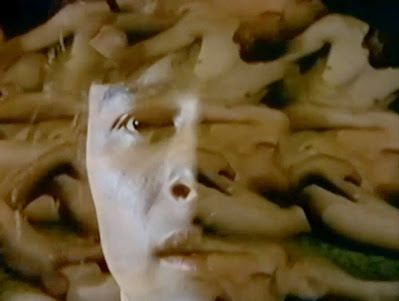 |
| Presenting “the acid test.” |
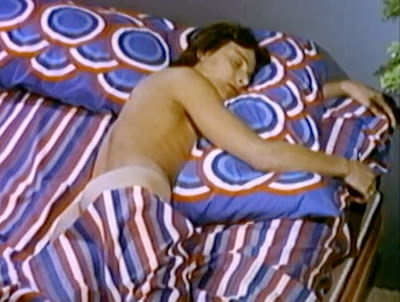 |
| From the Peter Max Nightmare Bedding Collection... |
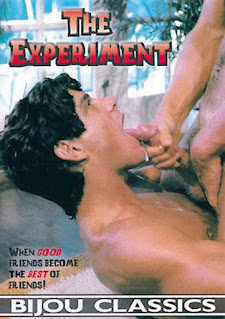 |
| The Experiment is available through Bijou Classics, and presumably so is the movie from which they grabbed that cover image. |
The Experiment was released by Jaguar Films, the same studio that released The Light from the Second Story Window. Like Second Story Window, The Experiment attempts to mimic mainstream Hollywood product and explore the struggles of being gay, as well as prominently feature Joey Daniels. Unlike Second Story Window, however, The Experiment succeeds by keeping its story simple, its scope small. It knows it can’t be a Douglas Sirk melodrama and doesn’t bother trying (though bless Second Story Window writer/director/star David Allen for going for it, budget and talent limitations be damned), Furthermore, The Experiment actually remembers it’s a porn film (though Hall reportedly preferred writing the scripts to directing the movies). It even has a few scenes that are borderline erotic. That said, the movie works better as a coming-of-age/coming out drama, so maybe don’t watch this one if you’re hoping to rub one out.
 |
| Billy Joe and Gary Lee try to decide if they are friends or fuck buddies. |

